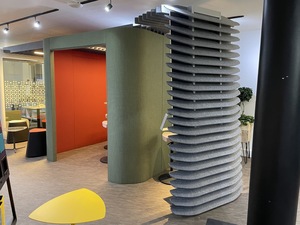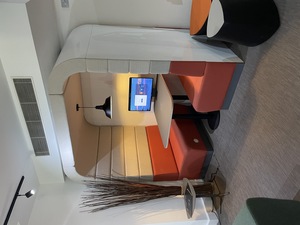
 |
Mark Sennett
Managing Editor |
 |
Kelly Rose
Editor |
| Home> | Managing Health & Safety | >Noise Monitoring | >Wait...did my office just get louder? |
Wait...did my office just get louder?
27 February 2023
OPEN PLAN office noise has long been problematic – but post-lockdown and with the rise of home and hybrid workers, it’s more of an issue than ever. Guy Osmond, Managing Director of Osmond Ergonomics, explores the challenges, the solutions – and even the benefits of being in a noisy office space.
After months spent working at home during lockdowns the return to open plan offices felt like an assault on the senses for many, with the office seemingly louder than before.
While typical offices register sound levels in the 45dB to 60dB range, well within the ‘safe’ range, that’s not to say that office noise doesn’t have an impact on health. Research carried out in the wake of the pandemic found open plan office noise, while it did not reduce immediate cognitive task performance when compared to a quieter environment, it did reduce psychological wellbeing.
Researchers used sensors to track changes in heart rate and sweat response – both reliable indicators of physiological stress – as well as facial emotion recognition software to assess emotional responses. Participants also used a mood-scale to self-report their feelings. Even after a short exposure, a causal relationship was found between open office noise and both stress and negative mood. Negative mood increased by 25% and sweat response by 34% [Sander, 2021].
Managing noise
While offices are probably no noisier, awareness of the need to mitigate the negative impact of noise has increased. The demand for equipment and furniture to manage the noise has certainly been amplified post-pandemic. We’ve seen orders for quieter working spaces like pods, hubs and soundproof phone boxes rise markedly, as have requests for sound absorbing panels, soft furnishing, screens, and green walls which all help dampen acoustic reverberation.
Ironically, the shift to hybrid working after Covid often means that fewer people are in at any one time so many workplaces may actually be quieter than before – but that can be a problem in itself. With fewer people in a space designed for more, a low noise level can feel uncomfortable, while every sound - a door slam, a phone call – is far more jarring than it would be with a comfortable background hum.
So, while you want to manage noise, you don’t want to eliminate it. Many companies, including my own, have opted to install ceiling speakers to provide background music, or even white noise. The most advanced systems come complete with microphones picking up sounds around the room so that noise cancelling frequencies can be pumped from the speakers to quell them.
The 4Cs and the benefits of a noisy office
At Osmond Ergonomics, our conversations are often framed by the four core working behaviours – Contemplation, Concentration, Communication and Collaboration – the 4Cs.
It’s important to design office spaces where people can find a quieter area for intense concentrated work, or somewhere calm and peaceful for deep reflection and contemplation but a balance must be struck. In fact, it is communication and collaboration behaviours which have come to the fore since the pandemic because, while the other two Cs are often – but not always – easier at home, collaboration and communication are usually best suited to the office.
While workers might feel as though they’re much more productive at home in peace, I would argue that, in an era of hybrid working, there is an even greater need to have access to a shared working environment – even if it is a slightly noisy one.
When team members can tune into others’ work discussions, they can chip in with support and information and resolve issues instantly. Such friction-free interactions, which avoid the need for emails back and forth, can boost productively and are especially useful for junior team members.
Just by being around others, employees absorb an enormous amount. They can acquire the shared language of a team, identify where knowledge and experience lie, absorb the tone and approach of colleagues, and learn from others how to handle difficult situations. This learning by osmosis is a powerful and yet effortless mechanism for assimilating the culture and values of an organisation – something which is much harder to achieve without a busy office setting.
Striking a balance
There is no one size fits all and much depends on the nature of the work, the culture of the organisation and the personality of the individual doing it. But noise certainly isn’t simply an enemy to be quashed. Rather, by taking it into consideration when designing working environments, a balance can be struck to optimise both individual and collective wellbeing and productivity.
References
Sander LE, Marques C, Birt J et al. (2021) Open-plan office noise is stressful: multimodal stress detection in a simulated work environment. Journal of Management & Organization 1-17.

























